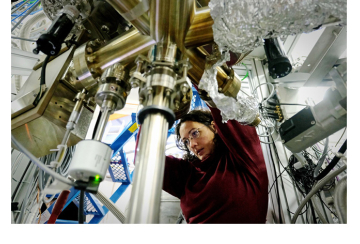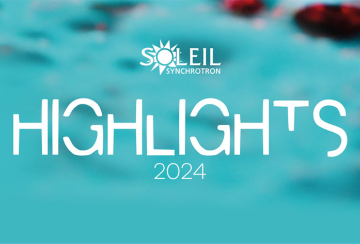
DEIMOS, Dichroism Experimental Installation for Magneto-Optical Spectroscopy, is a beam-line dedicated to the study of the magnetic and electronic properties using polarized light.
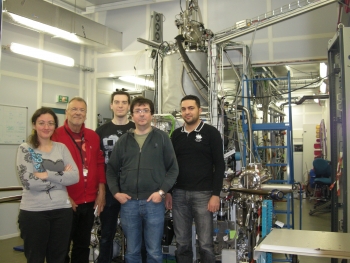 The application of synchrotron radiation to magnetism is related to the development of circularly polarized sources. The main advantage of X-ray Magnetic Circular Dichroism (XMCD) over other techniques addressing magnetic behavior lies in its chemical and orbital selectivity. One can probe the magnetic moment of one specific atom in a compound in which the absorbing atom is not a major component. Due to the electric dipole nature of the Hamiltonian interaction, one can also probe specific shells for which the magnetic orbital and magnetic spin moments can be “independently” measured. New physical and chemical properties shown by different classes of materials provide the basis for promising applications and challenging scientific investigations. The knowledge of the electronic structure of these materials is of crucial importance for the understanding and tailoring of well defined properties, like transport, magnetism and others.
The application of synchrotron radiation to magnetism is related to the development of circularly polarized sources. The main advantage of X-ray Magnetic Circular Dichroism (XMCD) over other techniques addressing magnetic behavior lies in its chemical and orbital selectivity. One can probe the magnetic moment of one specific atom in a compound in which the absorbing atom is not a major component. Due to the electric dipole nature of the Hamiltonian interaction, one can also probe specific shells for which the magnetic orbital and magnetic spin moments can be “independently” measured. New physical and chemical properties shown by different classes of materials provide the basis for promising applications and challenging scientific investigations. The knowledge of the electronic structure of these materials is of crucial importance for the understanding and tailoring of well defined properties, like transport, magnetism and others.
Team
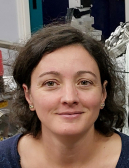


Job opportunities
Contact job offers
Current OPEN POSITION (deadline 11th of August 2023)
PhD position between DEIMOS - Synchrotron SOLEIL (Paris) and the University of Florence (Firenze Italy) on "LARGE SCALE FACILITIES BASED ULTRA-LOW TEMPERATURE MAGNETIC INVESTIGATION OF MOLECULAR SYSTEMS ASSEMBLED ON SURFACES".
Open position in collaboration between DEIMOS beamline at the SOLEIL Synchrotron and the Laboratory of Molecular Magnetism of the University of Florence (ITALY) for a specific project focused on the study at ultralow temperature (bellow 1K) of magnetic molecules. It is a 36 months PhD scholarship and it foresee 24 months stay in Firenze + 6 months stay at the SOLEIL Synchrotron + 6 months stay in another research institute to be defined with an agreement between the supervisor and the PhD student.
For further information contact: Prof. Matteo Mannini matteo.mannini@unifi.it
To apply: https://www.unifi.it/p12402.html
Technical data
350 – 2500 eV
E/ΔE between 6000 and 10000 over the whole energy range.
1st - APPLE II HU52 : Left - right circular polarizations, vertical and horizontal linear polarizations and tilted polarizations.
2nd - EMPHU65 will give 10Hz switching rate between circular left and right polarizations.
~ 2x1015 phot/s/0.1%bw @ 750eV
Double mirror (2 mirrors with 2 incidence angles, insuring a good harmonic rejection over the entire energy range);
PGM with VGD gratings working in the Petersen mode + multilayer gratings for the “high” energy range (>1500eV);
Post-focusing Wolter system.
The optics design is intended to give high stability and high spectral purity.
~80x80 µm² and ~800x800 µm2
~ 6x1012 phot/s/0.1%bw @ 750eV
CroMag : TEY (Total Electron Yield), TFY (Total Fluorescence Yield) and transmission.
MagneTwo : TEY (Total Electron Yield) FY (Total Fluorescence Yield) and SDD detector.
Scientific opportunities
| Surface and interface magnetism, Materials for spin electronics |
Magnetic properties of low dimensional structures – size effects; correlation between magnetic properties, morphology and structure - magnetoelastic effects, contributions in the magnetic anisotropy; magnetic moments and anisotropy of isolated atoms - tunneling surface diffusion at very low temperatures; ferromagnetic-antiferromagnetic interfaces – origin of the exchange coupling; magnetic tunnel junctions; etc. |
|---|---|
| Molecular magnets, Langmuir-Blodgett films, Hybrid magnetic materials, High spin molecules |
Magnetic and electronic properties of pure molecular magnets (dichroism of small magnetic polarization of the NO groups, with site selectivity); organo-metallic compounds and supramolecular assemblies – large variety of magnetic structures tuning chemical properties, “exotic” magnetic structures and mechanisms; lamellar compounds – ferrimagnetism, magnetic frustration; polynuclear molecules with monodisperse magnetic properties (moments and anisotropy) – molecular electronics, q-bits. |
| Superparamagnetic nanoparticles, Earth Science, Paleomagnetism |
Magnetic properties of variously synthesized particles of magnetite (Fe3O4), maghemite ((γ-Fe2O3), hematite (α-Fe2O3), pyrrhotite (Fe1-xS) or greigite (Fe3S4) - magnetic surface canting, chemical and magnetic disorder, vacancies ordering. |
Full description of the beamline can be found in the following reference : Ohresser, P., Otero, E., Choueikani, F., Chen, K., Stanescu, S., Deschamps, F., Moreno, T., Polack, F., Lagarde, B., Daguerre, J. P., Marteau, F., Scheurer, F., Joly, L., Kappler, J. P., Muller, B., Bunau, O., & Sainctavit, P., "DEIMOS: A beamline dedicated to dichroism measurements in the 350–2500 eV energy range", Review of Scientific Instruments, 2014, 85(1): art.n° 013106.

Sources
The photon source is constituted by two undulators : the HU-52, a 1.65 m long Apple-II helical undulator with a period of 52.4 mm, providing fully polarized light over the full energy range using the first, second and third harmonics. With circularly polarized light (left and right) the first harmonic covers the range ~260–1300 eV while horizontal and vertical linearly polarized light covers the range from 350 eV to 1150 eV.
The second undulator is an hybrid electromagnet/permanent magnet helical undulator (EMPHU) with a period of 65.0 mm optimized for a fast switching (5 Hz) of the circular polarized light, with no access to the pure linear horizontal polarization.

Apple-II undulator (left) ; EMPHU undulator (right)
The buffer chamber and DiagOn
The buffer chamber and the DiagOn (for Diagnostic Onduleur) are located in the radiation-protection hutch.
The pink beam emitted by the undulators can be visualized and characterized using the DiagOn device (diagnostic tool intended to precisely define the emission axis of the undulator [1].
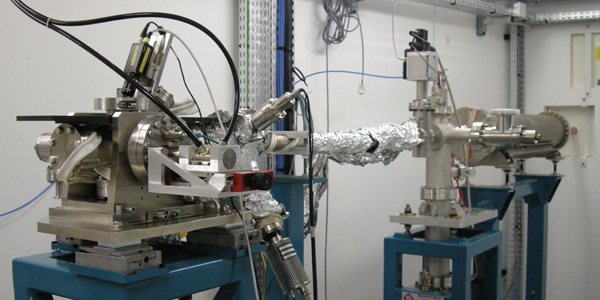
The first optics chamber
Also located in the radiation-protection hutch, the first optics chamber (a.k.a. M1 chamber) serves basically to remove the unwanted beams : higher harmonic rejection, heat load, Bremsstrahlung…
It contains 3 mirrors that are water cooled : first a plane mirror (Pt coated SiC-CVD), that dissipates a large part of the 160W in-coming power, followed by two toroidal mirrors (Pt coated Si and Rh coated Si) to choose from which focus the beam into the monochromator.

Monochromator
The monochromator is equipped with two plane gratings which are respectively a variable groove depth (VGD) grating with 1600 lines/mm, and a Mo2C/B4C alternate multilayer (AML) grating with 2400 lines/mm. The VGD grating is optimized for the energy range 240-1500 eV while the AML grating is optimized for the energy domain 1000-2500 eV.
With the VGD grating the monochromator is usually operated in the Petersen geometry with a fixed c factor that can be choose to either maximize the flux with a poor resolution (large value) or minimize the flux with an improve resolution (small value down to 0.04). The energy resolution is further defined by the opening of the exit slits located 4m downstream of the main UHV vessel. The ultimate resolving power (exit slits closed) is around 30000 for a factor c of 0.2.
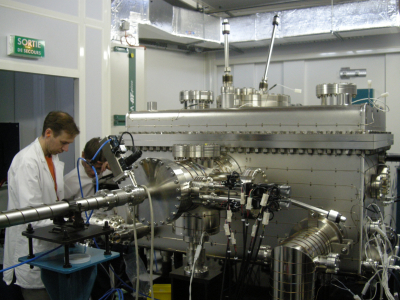
Refocussing (Wolter) chamber
The last optical stage is a simplified Wolter mirror combination associating a spherical mirror and a toroidal mirror. The choice between 2 spherical mirrors and 2 toroidal mirrors allows for 2 spot sizes ~80×80 mm2 and ~800×800 mm2 for the 2 working points (associate to the 2 workstations).
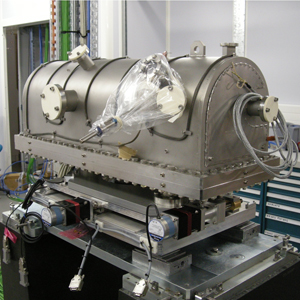
End-stations
Two end-stations are available on DEIMOS :
-
A superconducting magnet (CroMag) providing ±7 T along the x-rays beam or ±2 T perpendicular to the beam. A variable temperature insert (V2TI) has been developed for temperatures in the 1.5-350 K range. A new dilution insert is in development to go in the ultra low temperature range and is intended to cover the 0.2-350 K temperature range [2].
-
A 2T electromagnet (MagneTwo) allowing for a fast flipping of the magnetic field up to 1Hz. This end-station host several dedicated inserts: a high temperature insert (20-1000 K), an insert with multiple electrical connections (V²TI) (allowing for instance operando studies by applying voltages on a sample) [3] and a microfluidic insert for the studies of liquids.
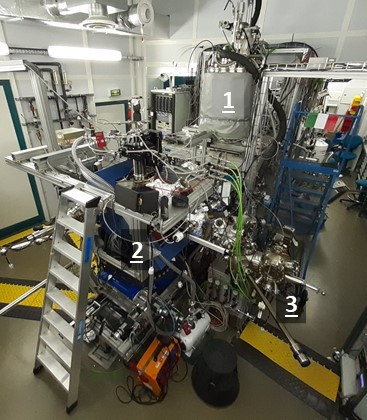
1- CroMag ; 2- MagneTwo ; 3- STM
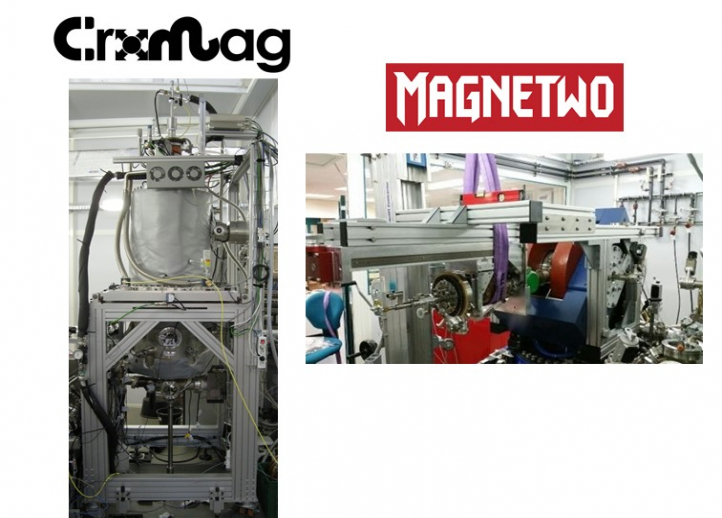
CroMag (left) ; MagneTwo (right)
You will find below the informations concerning the endstations :
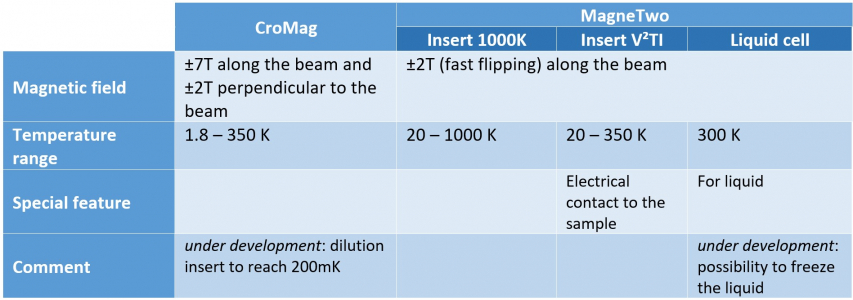
Here are three different types of inserts :

Liquid cell at the centre of the magnet (left), 1000K under soft X-rays beam (centre), T2VI insert (right).
[1] T. Moreno, E. Otero, P. Ohresser, "In situ characterization of undulator magnetic fields", Journal of Synchrotron Radiation 19(2): 179-184 (2012)
[2] Joly, L., Muller, B., Sternitzky, E., Faullumel, J. G., Boulard, A., Otero, E., Choueikani, F., Kappler, J. P., Studniarek, M., Bowen, M. and Ohresser, P., "Versatile variable temperature insert at the DEIMOS beamline for in situ electrical transport measurements", Journal of Synchrotron Radiation, 2016, 23 (3): 652-657.
[3] J.-P. Kappler, E. Otero, W. Li, L. Joly, G. Schmerber, B. Muller, F. Scheurer, F. Leduc, B. Gobaut, L. Poggini, G. Serrano, F. Choueikani, E. Lhotel, A. Cornia, R. Sessoli, M. Mannini, M.-A. Arrio, Ph. Sainctavit, and P. Ohresser, "Ultralow-temperature device dedicated to soft X-ray magnetic circular dichroism experiments", Journal of Synchrotron Radiation, 25(6): 1727-1735. (2018)
Sample preparation chambers
Connected to the end-station, there are several equipment allowing for the introduction and the preparation of the samples :
- A fast load-lock is used to transfer sample in the UHV environment common to both endstations. The load-lock can be connected to a glove box (6) allowing a transfer through inert atmosphere. Beside, the use of a UHV suit case is also possible to transport sample from a nearby laboratory to our set-up. Contact your local contact if you whish to use DEIMOS’s suitcase.
- The "MBE" chamber is hosting several UHV equipment for in situ sample characterization and preparation :
- Sample preparation :
- Ion sputtering,
- Omniax manipulator with a temperature range of 150-700K,
- Evaporation (also possible on the small side chamber Raoul-petite) :
- 2 Knudsen cells,
- 2 effusion cells for organics (5),
- 3 electrons beam evaporators (Omicron EFM-3 and EFM-3T) (3),
- Quartz microbalance,
- Sample characterization :
- Auger analyser (4),
- LEED (Low Energy Electron Diffraction) (2),
- Variable temperature STM (50-500K) (1).
- Sample preparation :
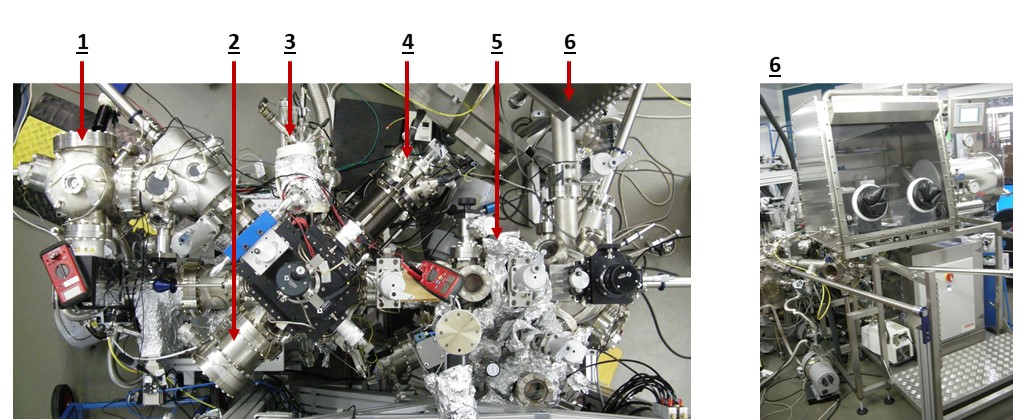
Sample holders
We can analyze most of solid samples: deposited on substrates or on single crystals, transparent, powder, etc... The samples can be prepared at users’ institute or directly on the beamline using our MBE vessel and other ancillary equipment (pdf).
CroMag :
We are using mainly 2 standards as sample holders : Omicron type plates and our copper block.
The samples can be fixed directly on the copper blocks (![]() click here for the schematic of a sample holder (59.65 KB)) and held by copper masks (see figure a-c) made-to-measure; maximum sample size 9x25mm2.
click here for the schematic of a sample holder (59.65 KB)) and held by copper masks (see figure a-c) made-to-measure; maximum sample size 9x25mm2.
The samples can also be assembled on ![]() Omicron type plates (62.99 KB) (pdf) available on DEIMOS, and can be held in place by wires, welded tabs, or screws. It is also possible to use our thickened plates; maximum sample size 10mm diameter (see figure d).
Omicron type plates (62.99 KB) (pdf) available on DEIMOS, and can be held in place by wires, welded tabs, or screws. It is also possible to use our thickened plates; maximum sample size 10mm diameter (see figure d).

Figure d : sample holder for Omicron type plate.
We also have a rotating sample holder (see figure e); maximum sample size 9x9mm2.
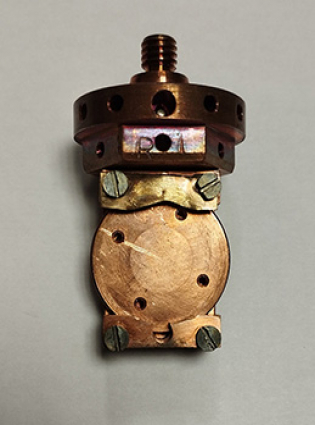
Figure e : rotating sample holder.
MagneTwo :
In MagneTwo, for measurements with the MilleK insert, samples must be mounted on Omicron type plates, for the V²TI insert requiring electrical contacts, samples are installed on electronic chips clipped on a dedicated copper block (see figure g), and for the microfluidic insert we use microfluidic chips (see figure i).
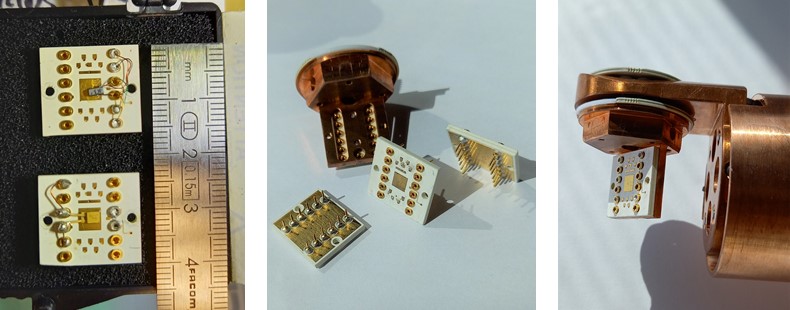
Figure f : example of samples installed on two electrical chips for V2TI.
Figure g : electrical chips with their dedicated copper block.
Figure h : electrical chip in place on the V2TI insert.
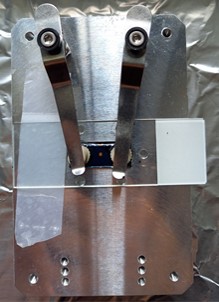
Figure i : microfluidic chip.
Sample loading
To insert the samples prepared ex situ, one usually uses the fast load lock (sas in French) (see photo below), or through the glove box (under inert atmosphere). It is also possible to use a UHV suitcase that can be connected to the sas via an intermediate pumping chamber (see photos below).
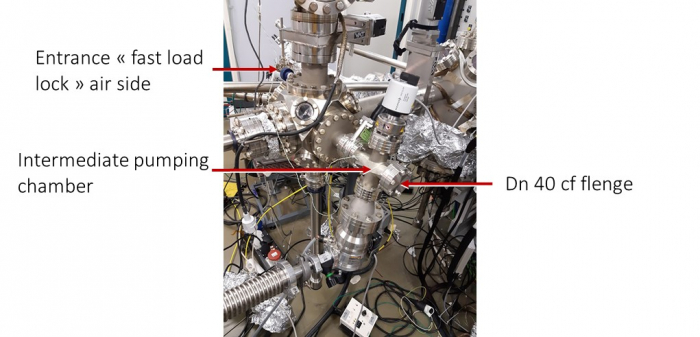

UHV case of 121,5cm.
The parking slot of our UHV suitcase can host up to 6 Omicron type plates (limited to 3 for thick samples) (see photo).
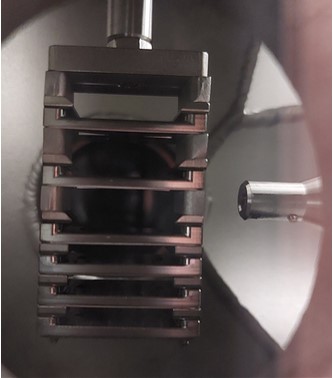
Contact your local contact for more information about the use of the DEIMOS UHV case. Click here for supplier information.
Control command and data acquisition
On DEIMOS the interface to control the beamline is using scripting based on the PyTango biding [1]. With a small list of commands, it is possible to launch "macro" consisting of a series of actions/commands (launching scans, moving actuators, …) written in Python in a text file easy to edit and modify.
Acquisition usually mostly consists in cumulating absorption spectra (performed at dedicated sample conditions and polarization) and magnetization curves.
There is 2 ways to record absorption spectra and the resulting dichroic spectra:
- turboscan: the turboscan is a continuous scan (or scan-on-the-fly) where the 2 rotations of the gratings and mirrors (both in the monochromators) are moved to cover the energy range of interest while at the same time the energy (gap) and polarization (phase) of the undulator is enslaved to the monochromator energy trajectory [2]. During these displacements the sensors, and actuators positions are synchronously recorded. This method allows for shorter acquisition time (no dead-times) and smoother data acquisition because there is only one single displacement. A typical turboscan (80eV wide) is obtained in 2-3 min. For a dichroic spectrum one needs at least 2 XAS but depending on the statistic and to cancel instrumental artefact it is usually mandatory to record many pairs.
- flipscan: the flipscan is a step-by-step scan where the light polarization (CR / CL, for circular right / left) (using the undulator EMPHU) or the magnetization (+H / -H) (2T electromagnet) is flipped at each point in energy. The step-by-step flipscan is typically 30-40 min long but is very powerful to resolve very small XMCD signals.
Similarly, there is 2 ways to measure magnetization curves:
- turbohyst: the sensors are synchronously recorded while the magnetic field is performing the desired trajectory in magnetic field. A complete magnetization curve is obtained by recording 2 turbohyst for the polarizations CR and CL with the energy set at the maximum of the XMCD signal. The total time requested is typically around 45 min (depends highly in the trajectory in field).
- fliphyst: the fliphyst is a step-by-step scan where the light polarization (CR / CL) (using the undulator EMPHU) is flipped at each point in magnetic field. The step-by-step fliphyst takes more time compared to the turbohyst but allows to resolve signal that are not easily measured with the later.
[1] PyTango documentation website.
[2] Joly, L., Otero, E., Choueikani, F., Marteau, F., Chapuis, L., & Ohresser, P., "Fast continuous energy scan with dynamic coupling of the monochromator and undulator at the DEIMOS beamline", Journal of Synchrotron Radiation, 2014, 21(3): 502–506
Contact
Philippe OHRESSER, Beamline Manager : 01 69 35 96 82, philippe.ohresser@synchrotron-soleil.fr
Phone number of the beamline DEIMOS : 01 69 35 81 51 ; 01 69 35 81 52
Adress for shipping goods :
Synchrotron SOLEIL
L'Orme des Merisiers
Departementale 128
91190 SAINT-AUBIN
FRANCE

